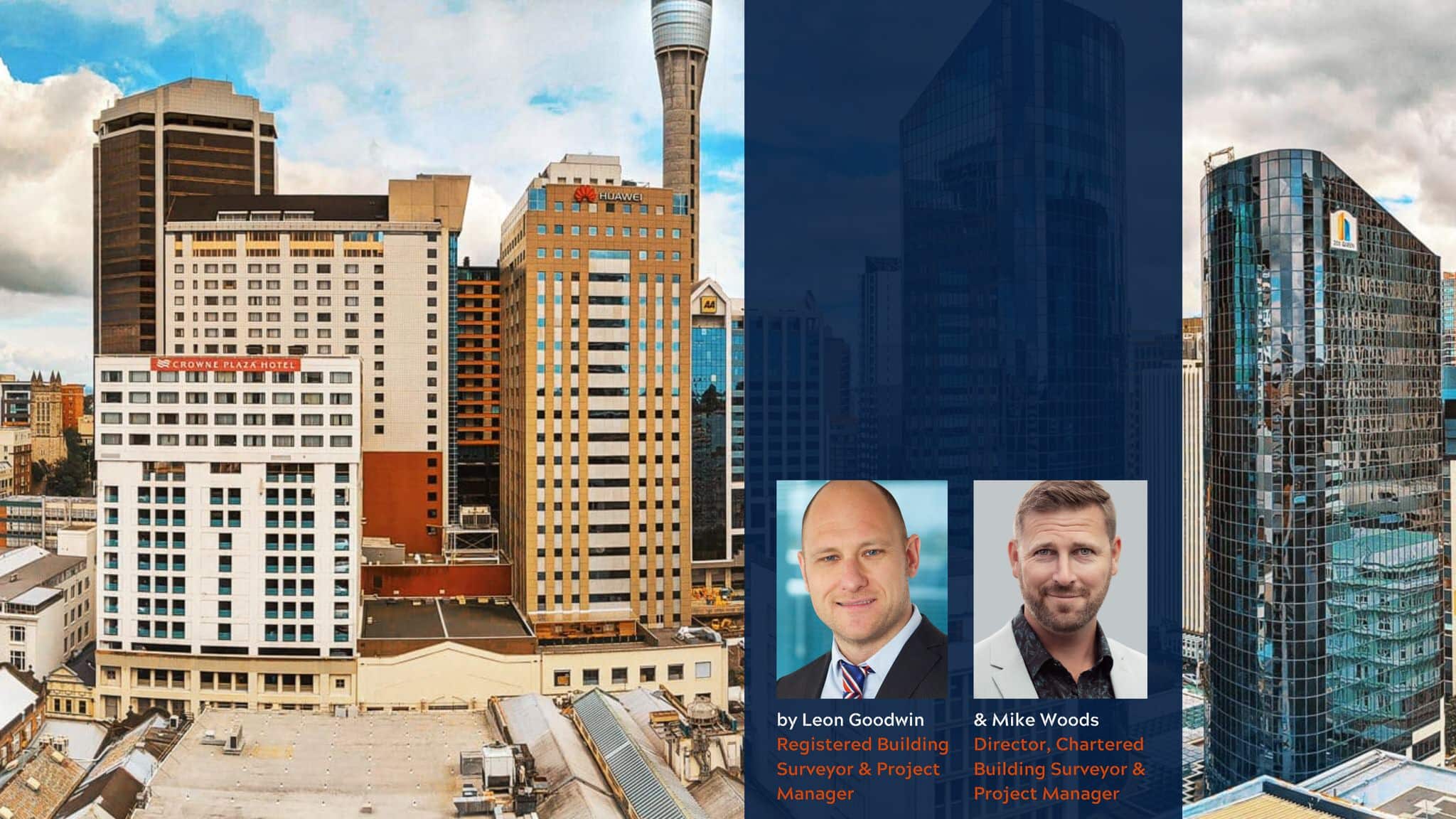As the economic downturn continues and office vacancy rates increase, many commercial property owners are considering new strategies for retention and future occupation of their buildings. Registered Building Surveyor Leon Goodwin and Chartered Building Surveyor Mike Woods explore one way in which investors can pivot to retain the value in their properties.
Office vacancy rates hit 15.2% in Auckland in the fourth quarter of 2024, and while Wellington and Christchurch both have lower vacancy rates, all three major centres have seen a rise in vacancies recently.
While the post-Covid trend towards working from home may be seeing a reversal in the current economic climate, this has – at least in part – been offset by the many businesses seeking to reduce staff numbers. Meanwhile, record numbers of online transactions and a growing number of distribution centres in NZ is a clear indication that online shopping is here to stay, putting further pressure on bricks-and-mortar retailers.
But demand for residential property – and in particular CBD residences – is as high as ever. Which means there may be a potentially positive option for owners of vacant or under-occupied office and retail property: converting commercial spaces into sought-after high-density residential housing.
The constant demand for housing and an increasing trend of residential conversions
New Zealand has a longstanding housing shortage, particularly in our largest cities. The constant housing demand is coupled with a clear intention from councils to intensify housing in CBD areas. This presents an opportunity for investors or owners of commercial property to potentially realise a greater return by converting their properties to residential space.
The conversion of offices and retail buildings into residential units is a trend that’s been unfolding in the UK and Europe for several years. It is likely to only increase as current trends continue, and permitted development rights are further relaxed to address the need for more housing.
Two of the most high-profile examples in London were the conversion of the iconic television centre in White City, and ‘Delta Point’ development in Croydon, South London, where 29,000sqm of office space was converted into 348 new homes.
It’s also something we’re seeing more of in New Zealand. Completed in 2022, the 18-storey CAB building in Aotea Square was converted into a 118-apartment block, breathing new life into the unoccupied Auckland City Council Administration Building.
Another major development in Auckland’s CBD – The Domain Collection – is scheduled for completion in 2026, and will see the former Fidelity Life headquarters redeveloped into luxury city-centre apartments.
Partial residential conversions are also a possibility, like the 51 Albert Street tower, also in Auckland’s CBD, which houses a hotel and eateries on the lower floors, with a number of private apartments above, on the site of an old auto showroom.
We’re likely to see more of these projects across our main cities, and it could be a welcome change. Not only does it provide much-needed housing in areas of high demand across the country, particularly in CBD locations, it also gives commercial property owners the respite they need from decreased tenant demand and reduced commercial rents.
Feasibility is key when converting commercial property to residential
The first and most important question to ask when considering a commercial to residential conversion is that of feasibility. This is actually a two-part question, considering both practical and economic feasibility. The fact is, not every office or retail space is suitable for conversion, and not every commercial space will deliver value when converted to residential. Establishing the answers to these questions at the earliest stages is critical.
From a practical standpoint, will your commercial space allow for a quality living environment that is desirable to potential residents? Most office and retail spaces have been designed for their original intended use, not to be used as a living space. This means careful consideration must be given to natural light, adequate ventilation, and whether you have the room required to provide decent sized living spaces. Even when a space is suitable, there will still be many practical issues to overcome, such as structural and seismic considerations.
You’ll also need to consider whether there are any local planning restrictions that may prevent development or influence the design. For example, some locations have covenants preventing residential dwellings, while others are not currently zoned for residential use. You also need to determine whether the property’s existing utilities will provide sufficient output to supply multiple dwellings rather than one large office space. The Resource Management Act, which covers any intended change of use for a property, should be consulted for any potential barriers too.
When it comes to economic feasibility, will the eventual value realised through converting be more than the costs involved? There is little point converting a commercial space if the costs of doing so will outweigh the potential return.
To realise the greatest profit, it’s important to assess the potential of the existing building and the site to understand what is possible in terms of expansion or repurposing – and, more importantly, what this might cost. There could be far more options open to you than just reconfiguring the existing internal space. Could you add a rooftop development? Are you able to extend the building within the boundary to allow for additional units? How can you best maximise the existing fabric of the building to minimise structural changes? All of these considerations can influence the economic feasibility of a conversion project, and choosing the right approach can make a big difference to your bottom line.
It takes a team of qualified consultants to make it happen
The considerations above are just the tip of the iceberg, and will undoubtedly seem daunting to most owners or investors. But as with all projects, the outcome will depend on the people you have behind you.
It takes a team of qualified consultants to answer these questions effectively, and to deal with the many unknowns that will crop up along the way. An experienced Building Surveyor is an invaluable partner from the outset, who can help you investigate the potential of your property, understand the hurdles to overcome, and assess your options to uncover the best way forward.
But they are just one part of the puzzle. A skilled designer with experience in refurbishments and conversions will know how best to maximise value from the available space and budget, and a structural engineer will undoubtedly also need to be involved. A Registered Property Valuer, together with a professional Quantity Surveyor, will be able to answer the questions of financial feasibility, by assessing both the cost and eventual value of any planned conversion. And let’s not overlook the importance of an experienced Project Manager to coordinate the entire process from start to finish and ensure a successful and profitable outcome.
At Prendos, were one of the few companies in NZ to offer a truly multidisciplinary consultancy service incorporating all the key disciplines required for this type of project. Our Building Surveyors are also skilled Project Managers with over 35 years’ experience of property refurbishments, new builds and conversions. They work with our in-house team of Architects, Quantity Surveyors, Structural Engineers and Valuers to take your project from investigation through construction to successful completion.
Having all your key consultants under one roof results in better communication, and no costly overlap of professional services from different providers. Our team work collaboratively across disciplines, resulting in a more streamlined and cost-effective project.
We know how to unlock the potential value of any building while sticking within the confines of the council and RMA. What’s more, we will always be bold enough to state when a site is not suitable, or to suggest an alternative when we believe the proposed plan will not result in a quality or profitable outcome.
If you’re a commercial property owner or investor interested in future proofing your investment, give us a call. It doesn’t hurt to explore your options – especially in such an uncertain economic environment. Change can be positive, and we believe there are always ways to pivot and adapt your asset to suit the new property landscape.
Commercial to residential conversions: key things to consider
If you want to convert your commercial property into high quality homes that are beneficial to all stakeholders, there are some important factors that will put you on the path to success …
- Does the space allow for quality living conditions? Does it provide decent sized living spaces and offer natural light and ventilation?
- Does the clear span of the building allow for the internal alterations required to create residential properties of appropriate sizes, proportions and space standards?
- Are there any local planning restrictions that may prevent or affect development?
- Do existing utilities provide sufficient capacity to supply multiple properties rather than one large office space? Is there appropriate drainage to support multiple units without impeding the layout? Retaining the existing utilities and drainage setup will allow you to significantly minimise build costs.
- How can you maximise the existing fabric and minimise structural change? This is crucial to maximise profitability.
- Have you investigated the potential of the site? It’s important to understand the feasibility of extending the building within the boundary to allow for additional units. Remember to pay careful consideration to parking arrangements.
- Have you considered adding a rooftop development under a separate planning application? This will allow a greater number of spacious units to be created.
- What sustainable materials and technologies can you incorporate to reduce the energy use and carbon footprint? This is an essential consideration, as the building was not intended for residential use. A ‘fabric first’ approach is key while ensuring the usable floor area is not impacted.
Prendos has offices across New Zealand, so wherever your property is we’re happy to discuss your conversion options – no matter how far down the track you are in your planning. Fill in the form below, contact us on 0800 PRENDOS, or email prendos@prendos.co.nz


